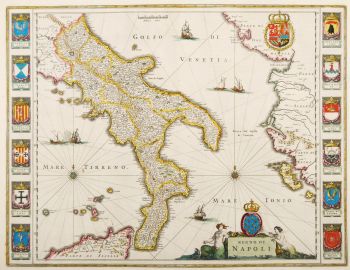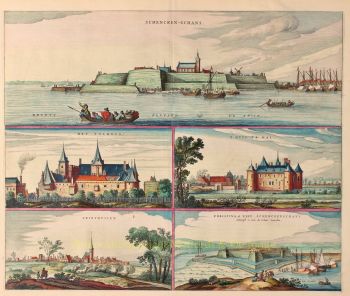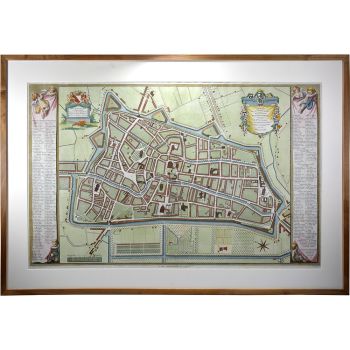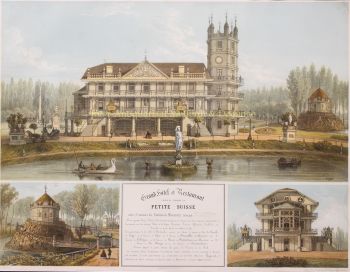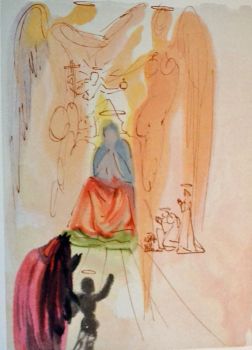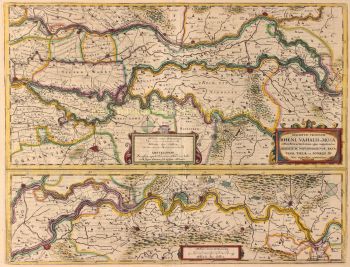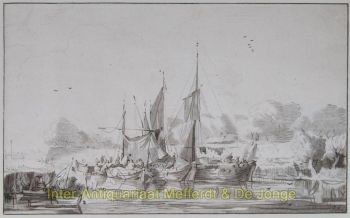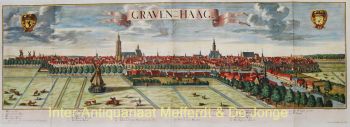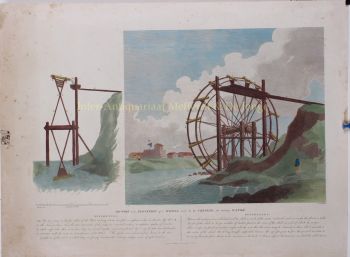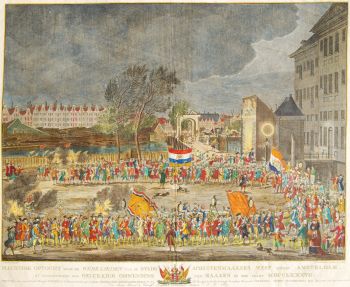Arnhem 1649
Joan Blaeu
€ 750
Inter-Antiquariaat Mefferdt & De Jonge
- Sobre arte
PLATTEGROND OF 17E-EEU ARNHEM "Aernhem", copper engraving by Joan Blaeu, as part of his "Toonneel der Steden", published in 1649 in Amsterdam. Later hand-coloured. Verso: Latin text. Sizes: 41 x 52,5 cm. The map was not drawn by Joan Blaeu, but by the cartographer Nicolaes van Geelkercken in 1639. Van Geelkercken received the commission for this from the Arnhem city council in 1638. The map thus reflects the situation around 1639. Van Geelkercken's design is not only found in this edition by Blaeu, but the printers Johannes Janssonius and Frederik de Wit also published variations on the map. Blaeu describes the city as follows: Arnhem is the capital of the Veluwe and seat of the highest court of the Duchy of Gelre. The city is "mighty, glorious, strong and rich in citizens". The Rhine flows along the city wall and the air is good because of the surrounding forests. In the surrounding area, the citizens have pleasant courtyards and gardens. On the side of the Veluwe, in the direction of Maastricht, there is a hill outside the city, "from the welcke sich a lustige aenschouwing over de naeste landen van de Betuwe vert vert vert". North of the town are hills and valleys planted with woods and heathland, where various kinds of wild animals are hunted. There is also the Wildhaen, once the hunting ground of the dukes, now "very useful for a walk for the citizens". To the south of the town, on the other side of the Rhine, are the beautiful fields of the Betuwe, where many oats, barley, peas, beans and other grain crops grow. Against "the violence from outside" the city has five "as strong as a castle" gates (four are made of stone). Of these, St. John's Gate was built in 1537 by Charles of Gelre, who feared the arrival of Charles V. Blaeu writes about the nature of the citizens that they are "courteous and lovers of science, and many live there from noble families". They are also heroic. Think of the city of Neuss that was helped by the citizens of Arnhemm during the siege by Charles the Bold. They also provided help during the terrible fire of Harderwijk in 1503. The city has a chapter of canons [in the St. Walburgis church], a Franciscan monastery [Broeren church on the map] and an Agnietenklooster [which passed into the hands of the St. Catharina Gasthuis in 1636]. The Commanderij van Sint-Jan is home to the Hospitaller knights, who used to collect a toll at the Janspoort on goods imported from the Veluwe, until this privilege was bought off by the bishop of Utrecht. In the Grote Kerk, with its beautiful tower, Duke Charles of Gelre is buried "in the inner court, of carved marble". See here for a nice animation of 17th century Arnhem. Price: Euro 750,-
- Sobre artista
Joan Blaeu (1596-1673), nasceu em 23 de setembro de 1596 em Alkmaar.
Ele era um cartógrafo holandês nascido em Alkmaar. Ele seguiu os passos de seu pai, o cartógrafo Willem Blaeu.
Em 1620 tornou-se doutor em direito, mas ingressou no trabalho de seu pai. Em 1635 publicaram o Atlas Novus (título completo: Theatrum orbis terrarum, sive, Atlas novus) em dois volumes. Joan e seu irmão Cornelius assumiram o estúdio depois que seu pai morreu em 1638. Joan tornou-se o cartógrafo oficial da Companhia Holandesa das Índias Orientais.
O mapa-múndi de Blaeu, Nova et Accuratissima Terrarum Orbis Tabula, incorporando as descobertas de Abel Tasman, foi publicado em 1648. Este mapa foi revolucionário porque "descreve o sistema solar de acordo com as teorias heliocêntricas de Nicolau Copérnico, que mostram a Terra girando o sol... Embora o livro inovador de Copérnico Sobre as Revoluções das Esferas tenha sido impresso pela primeira vez em 1543, pouco mais de um século antes, Blaeu foi o primeiro cartógrafo a incorporar essa revolucionária teoria heliocêntrica em um mapa do mundo."
O mapa de Blaeu foi copiado para o mapa-múndi colocado na calçada do Groote Burger-Zaal da nova Prefeitura de Amsterdã, projetado pelo arquiteto holandês Jacob van Campen (agora Palácio Real de Amsterdã), em 1655.
A Hollandia Nova de Blaeu também foi retratada em seu Archipelagus Orientalis sive Asiaticus, publicado em 1659 no Kurfürsten Atlas (Atlas do Grande Eleitor). e usado por Melchisédech Thévenot para produzir seu mapa, Hollandia Nova—Terre Australe (1664).
Como "Jean Blaeu", ele também publicou o volume 12 "Le Grand Atlas, ou Cosmographie blaviane, en laquelle est exactement descritte la terre, la mer, et le ciel". Uma edição é datada de 1663. Era fólio (540 x 340 mm) e continha 593 mapas e placas gravadas. Em março de 2015, uma cópia estava à venda por £ 750.000.
Por volta de 1649, Joan Blaeu publicou uma coleção de mapas de cidades holandesas chamada Toonneel der Steeden (Visões de cidades). Em 1651 ele foi eleito para o conselho de Amsterdã. Em 1654, Joan publicou o primeiro atlas da Escócia, elaborado por Timothy Pont. Em 1662 reeditou o Atlas Novus, também conhecido como Atlas Maior, em 11 volumes, sendo um para os oceanos.
Uma cosmologia foi planejada como seu próximo projeto, mas um incêndio destruiu o estúdio completamente em 1672.
Joan Blaeu morreu em Amsterdã no ano seguinte, 1673. Ele foi enterrado no Westerkerk em Amsterdã.
Você está interessado em comprar esta obra de arte?
Artwork details
Related artworks
- 1 - 4 / 12
- 1 - 4 / 24
Cornelis Anthonisz Theunissen
ZEER ZELDZAME EERSTE GEDRUKTE KAART VAN AMSTERDAM, EEN STAD IN OPKOMST1544
€ 175.000Inter-Antiquariaat Mefferdt & De Jonge
 Gecureerd door
Gecureerd doorDanny Bree
1 - 4 / 12






